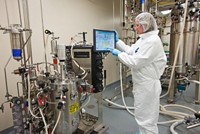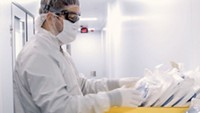Advertisement
Grab your lab coat. Let's get started
Welcome!
Welcome!
Create an account below to get 6 C&EN articles per month, receive newsletters and more - all free.
It seems this is your first time logging in online. Please enter the following information to continue.
As an ACS member you automatically get access to this site. All we need is few more details to create your reading experience.
Not you? Sign in with a different account.
Not you? Sign in with a different account.
ERROR 1
ERROR 1
ERROR 2
ERROR 2
ERROR 2
ERROR 2
ERROR 2
Password and Confirm password must match.
If you have an ACS member number, please enter it here so we can link this account to your membership. (optional)
ERROR 2
ACS values your privacy. By submitting your information, you are gaining access to C&EN and subscribing to our weekly newsletter. We use the information you provide to make your reading experience better, and we will never sell your data to third party members.
Gene Therapy
Catalent to acquire gene therapy service firm Paragon
The $1.2 billion deal is the latest designed to support the flood of gene therapies in development
by Lisa M. Jarvis
April 15, 2019
Manufacturing mania
Investment in gene therapy capacity has exploded
April 2019
Catalent agrees to pay $1.2 billion for Paragon Bioservices
March 2019
Thermo Fisher buys Brammer Bio for $1.7 billion
March 2019
Bluebird Bio opens gene and cell therapy manufacturing site in Durham, North Carolina
October 2018
Novasep opens viral vector production facility in Seneffe, Belgium
April 2018
Lonza opens industry’s largest dedicated gene and cell therapy manufacturing plant outside of Houston
Seeking to enter the business of gene therapy manufacturing, the drug service firm Catalent Pharma Solutions has agreed to pay $1.2 billion for the custom manufacturer Paragon Bioservices.
Paragon will put Catalent in the business of making adeno-associated virus vectors, plasmids, and lentivirus vectors used to deliver gene and cell therapies. Earlier this month, Paragon opened a gene therapy manufacturing facility in Maryland’s Anne Arundel County, complementing the production capacity at its headquarters at University of Maryland’s BioPark.
The new capacity will support customers’ clinical- and commercial-stage programs. After the Catalent deal was unveiled, Paragon announced it will expand its relationship with a key customer, Sarepta Therapeutics. In October, Sarepta enlisted Paragon to help make its experimental Duchenne muscular dystrophy gene therapy; Now, Paragon and Sarepta are considering a joint venture to manufacture gene therapies at a new site.
The deal for Paragon, which expects to have sales of $200 million this year, is part of a feeding frenzy in the gene therapy arena. So far, the US Food and Drug Administration has given its nod to just one gene therapy: Spark Therapeutics’ Luxturna, which in December 2017 was approved to treat a rare, inherited form of blindness. But the FDA recently said that by next year it expects to receive more than 200 requests annually for permission to begin clinical studies of cell and gene therapies. By 2025, as many as 20 new such therapies could be approved each year, the agency predicts.
Contract manufacturing organizations (CMOs) and drug developers alike are scrambling to figure out how to manage that wave of therapeutics.
“There are hundreds, if not thousands, of gene therapy programs being developed globally, which is creating a huge backlog and long wait times at CMOs that have the capability to manufacture these products,” says Katie W. McCarthy, chief development officer at Halloran Consulting Group. “Competition for manufacturing slots is fierce, and the long lead times can drastically slow down the forward progress of a development program.”
As a consequence, CMOs are scrambling to buy or build capacity. The Catalent deal comes just weeks after Thermo Fisher Scientific said it will buy the viral vector contract manufacturer Brammer Bio for $1.7 billion. Other CMOs are sinking significant cash into new facilities.
While service firms like Catalent and Thermo Fisher snap up specialists in gene and cell therapy production, drug companies are gobbling up gene therapy-focused biotech firms. In the past year, some of the industry’s biggest acquisitions have been of gene therapy companies, including Novartis’ $8.7 billion acquisition of AveXis and Roche’s $4.8 billion deal for Spark. Both deals brought pipeline of treatments and sizable manufacturing facilities.
For firms like Novartis and Roche, acquiring companies with production capacity creates more certainty in development timelines. “If you build it yourself and bring the capability in house, you won’t need to get in line for slots at external CMOs,” McCarthy says.




Join the conversation
Contact the reporter
Submit a Letter to the Editor for publication
Engage with us on Twitter